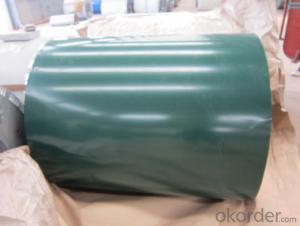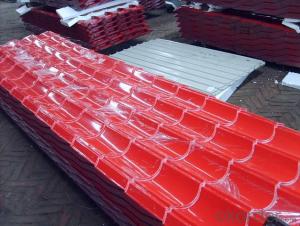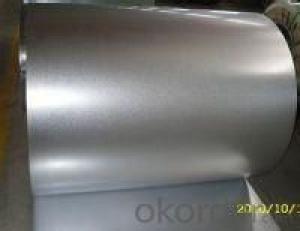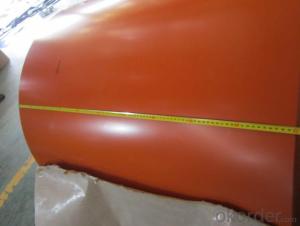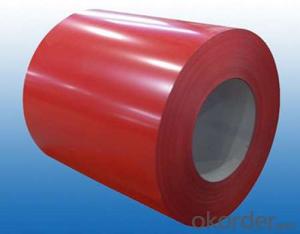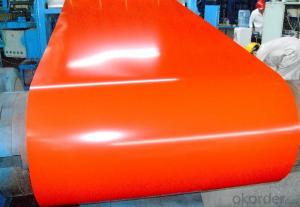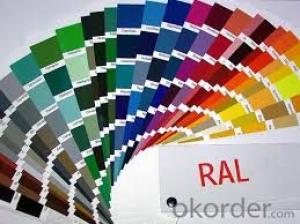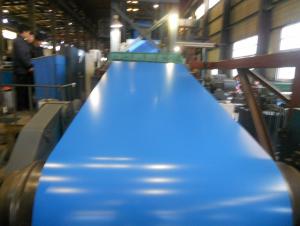Colored Pre-Painted Galvanized Steel-Coil
- Loading Port:
- Tianjin
- Payment Terms:
- TT OR LC
- Min Order Qty:
- 25 m.t.
- Supply Capability:
- 1000 m.t./month
OKorder Service Pledge
OKorder Financial Service
You Might Also Like
Description:
The production process has evolved from one coating and one baking to double-coating-and-double-baking, and even three-coating-and-three-baking.
The hot dip metallic coating process is also used to manufacture steel sheet and coil with coatings of aluminium, or alloy coatings of zinc/aluminium.
Metallic coated steel is cleaned, pre-treated, applied with various layers of organic coatings which can be paints, vinyl dispersions, or laminates.The continuous process used to apply these coatings is often referred to as coil coating.
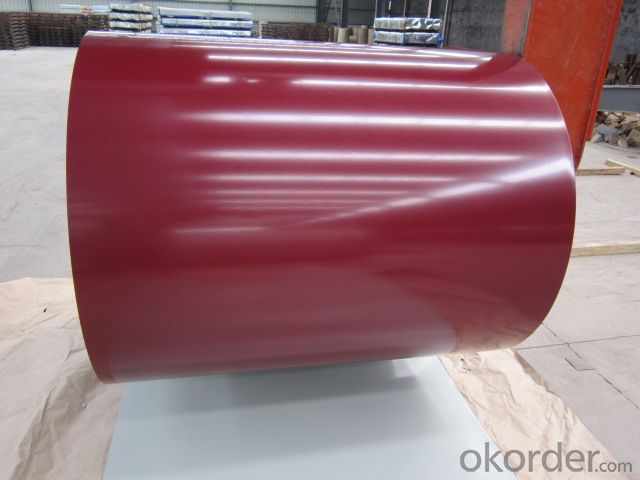
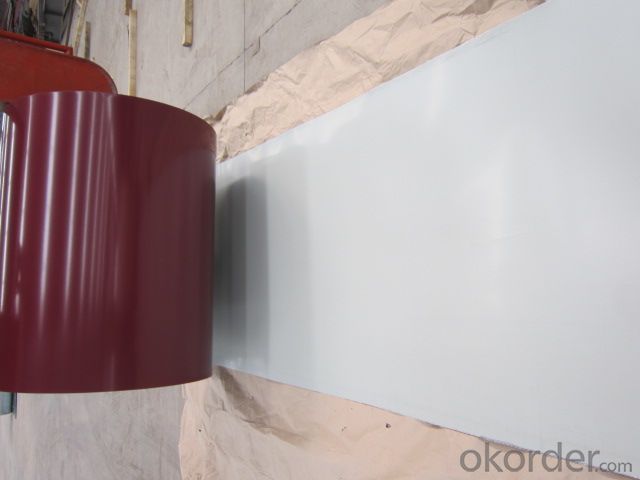
Application:
Suitable for indoor or outdoor decoration, color lasting for at least 10 years for outdoor using, could for roll forming., conditioning, micro-wave oven, bread maker,Blackboard, white board,chalkboard, hidden cell blackboard,bulletin board.
Central heating slice, lampshade, chifforobe, desk, bed, locker, bookshelf,garbage can, billboard, typewriter, instrument panel, weight sensor, photographic equipment,coffin, fence, Prepainted Galvanized Steel Coil
Product Specification:
Paint: PE or PVDF
Color pre painted steel in coil
Thickness: 0.3-0.8mm
Width: 914-1250mm
Inner Diameter: 508mm,610MM
Weight of Steel Coil: 3-7MT
Available Dipped Layer: 50-150g/m2
Standard:JIS G3312,CGCC
FAQ:
1.Can you produce the goods according to the customer’s requirements?
Yes, of course, it can be customized according to customers requirements.
2.How about the color of the Pre Painted Steel Coil
The color of the Pre Painted Steel Coil has a very wide selection, like orange, cream-colored, dark sky blue, sea blue, bright red, brick red, ivory white, porcelain blue.
3.Could you tell me the package for the Pre Painted Steel Coil?
Usually Standard export seaworthy package: waterproof paper and steel trip packed and wooden case seaworthy package
- Q: I understand that damascus sword steel was made by folding the strip of steele double , reheating, hammering, folding again and so forth hundreds of times. Was this the same or very nearly the same techmique the japs used making the sword blades the samari swords?(forgive the misspelling)
- Actualy, the secrets of forging Damascus steel has been rediscovered. In the 1970s, a Russian scientist found that he could duplicate the steel found in old Damascene swords. While it is true that such swords (which have to be made by hand) would be more expensive than usual, you must keep in mind that the majority of Damascus swords are still forged in Damascus. Syria is a highly inexpensive country, and the price of a Damascus blade, while being expensive to Syrians, would be cheap to Westerners. In reference to your question about wether there is anything special about Damascus steel, the answer is yes. At the time of its creation, Damascus steel was the lightest and most flexiable metal known to man, even lighter than the steel Katana swords used by the Samurai of Japan. During the Crusades, Europeans reported that the Arab blades were capable of bending in the wind, and floating on water. While these are certainly exaggerations, they are proof that Damascus blades were far lighter and stronger than the crude iron weapons used by the Crusaders.
- Q: How are steel coils used in the production of gutters and downspouts?
- Steel coils are used in the production of gutters and downspouts as they are uncoiled and fed into a roll-forming machine. This machine shapes and cuts the steel into the desired gutter or downspout profiles. The steel coils provide the necessary raw material for creating durable and long-lasting gutters and downspouts that effectively channel rainwater away from buildings.
- Q: How can I arbitrate quality of steel before purchasing it??
- The quality of the alloy can be very well be judged by its appearance and lustrous surface. The more luster on the surface the more refine will the steel be. To judge its tenacity and endurance, the alloy can be subjected to a series of procedures involving stress and shock. The reaction to these processes can determine whether the steel be fit for the purpose required.
- Q: looking for a good pocket knife. i keep going through these 440 steel pocket knives with every day work usage. this will be my 4th. even when i use a whetstone they stay sharp for a short period of time but the edge does not last, 440 is too soft! what is a good steel to look for in a pocket knife? also what are some good brands. ive been using gerber and buck sofar. if you could recommend me a few mid/small sized knives i would greatly appreciate it!
- There okorder /
- Q: How are steel coils processed before being used in manufacturing?
- Steel coils undergo several processing steps before they are used in manufacturing. The first step is to uncoil the steel coil, which involves unwinding it from a large spool. This is usually done using a machine called a decoiler. Once the coil is uncoiled, it is inspected for any defects or damages. After inspection, the steel coil goes through a process called leveling. This process involves passing the coil through a series of rollers to remove any unevenness or waviness in the steel. Leveling ensures that the coil has a uniform thickness and flat surface, which is crucial for further processing. The next step is to clean the steel coil to remove any impurities, such as rust, oil, or dirt. This is usually done by running the coil through a cleaning line, where it is treated with chemicals and water sprays. The cleaning process ensures that the surface of the coil is free from contaminants, which can affect the quality of the final product. Once the coil is cleaned, it may undergo additional processes depending on the specific requirements of the manufacturing process. For example, the coil may be annealed to improve its ductility and reduce its hardness. Annealing involves heating the coil to a specific temperature and then slowly cooling it. This process helps to relieve internal stresses and improve the steel's mechanical properties. After all the necessary processing steps are completed, the steel coil is ready to be used in manufacturing. It can be further processed into various shapes and forms, such as sheets, plates, or strips, depending on the specific requirements of the manufacturing process. These processed steel coils are then used in a wide range of industries, including automotive, construction, appliances, and machinery.
- Q: I bought a stainless steel mood ring two days ago, but would it rust?Thanks in advance!
- Stainless Steel does not rust...that is why it is used in our kitchens and the top kitchens of the world...!! sorry...Stainless Steel does not Tarnish either!
- Q: I am building a robot for Bots IQ. In doing so i have the option of building the the armor of my robot out of titanium or tool steel.. which would be the better option.Brief description of Bots IQ: It is a competition where 2 15lb robots go and attack each other with spinning blades, hammers or whatever is designed.
- Titanium is a significantly stronger and lighter metal, but is also extremely expensive. If you have the option for titanium, go for it.
- Q: I know that carbon steels and alloy steels are different but are carbon steels still alloys?Thanks!
- Carbon steels are alloys. This is evident in the carbon-iron phase diagram:
- Q: I have been wanting a new pair of hiking boots, but haven't had the money. I just got a job that requires me to have steel toed boots. The job is only for a few weeks, but I may be required to wear them on other jobs in the future. Regardless of which style I get, I will most likely be buying Red Wing boots. On their website, I see they have steel toed hiking boots. What is the purpose of a steel toed hiking boot? Why would a hiker need to have steel toed boots? Wouldn't that just be more weight? I see that some of their hiking boots have aluminum toes, claiming to be 33% lighter than steel with the same protection. Would these boots be good potential hiking boots as well as suitable for construction or should I just focus on work boots and buy myself some hiking boots at a later date?
- This Site Might Help You. RE: Are steel toed hiking boots worth buying? I have been wanting a new pair of hiking boots, but haven't had the money. I just got a job that requires me to have steel toed boots. The job is only for a few weeks, but I may be required to wear them on other jobs in the future. Regardless of which style I get, I will most likely be...
- Q: Is infi steel as good as busse knives make it sound. If so why don't any other brands use it. Also are there any tactical folders that use infi steel. If infi isn't as good as it's cracked up to be then what is the best alternative.
- Infi Steel Knives
Send your message to us
Colored Pre-Painted Galvanized Steel-Coil
- Loading Port:
- Tianjin
- Payment Terms:
- TT OR LC
- Min Order Qty:
- 25 m.t.
- Supply Capability:
- 1000 m.t./month
OKorder Service Pledge
OKorder Financial Service
Similar products
Hot products
Hot Searches
Related keywords
